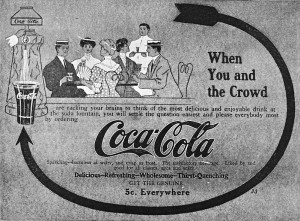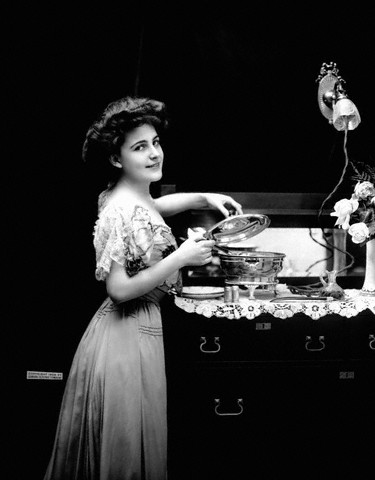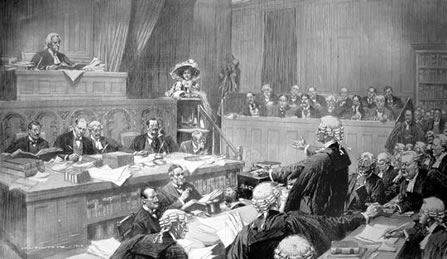In a 1914 issue of Cosmopolitan, Coca-Cola Vice President Samuel Candler Dobbs recounts the history of the drink and the company:
When Coca-Cola was first offered to the trade the soda water business was an insignificant item in both confectionery and drug stores.
Coca-Cola sales in its first year were extremely small, about 25 gallons were sold to local dealers in Atlanta, Georgia, and nearby towns. That was in 1886.
In 1887 small advertisements were run in Atlanta, Columbus, Birmingham and Memphis newspapers, about 1,000 gallons being sold that year. The business grew slowly, but the sales were gradually extended until Coca-Cola could be found in most of the principal cities of the country.
In 1905 The Coca-Cola Company, feeling the need of a nationalized influence, began the use of standard magazines, both monthly and weekly publications. The increase in the sales of Coca-Cola from that time to the present time have been little short of marvelous. The first year showed an increase of nearly a half million gallons; the next year about six hundred thousand gallons.
Later newspapers were added, and today the announcement to the public that ‘Coca Cola is Delicious and Refreshing’ is to be found during the season from the first of April until the first of October, in the principal magazines, and weekly and daily newspapers of this country.
Having no distinctive package to advertise, The Coca-Cola Company has persistently used its peculiar trade mark script, with the catchlines, ‘Delicious and Refreshing,’ usually accompanied by an illustration of a soda fountain or a glass of Coca-Cola, and the curved arrow which has become so much a part of their advertising, linking the name to the product, until to-day wherever observers see an arrow they almost involuntarily think of Coca-Cola.
But this business has not been built up without the expenditure of vast sums of money and a great deal of hard work. Like all great successes Coca-Cola has found its enemies. These attacks have emanated from the misinformed, from the envious, and sometimes from those seeking the natural publicity which comes from attacking a nationalized product.
Recently the mere attacks that have been made against the product culminated in one especially vigorous action brought by the Government to determine whether Coca-Cola was really deleterious, or misbranded under the National Food Law. This attack was defeated, the Circuit Court of Appeals deciding that Coca-Cola was not manufactured, made or sold in violation of the Food Law. That decision can best be summarized in the words of the court:
“No example is so clear as the very one here involved. Every member of Congress has been familiar from childhood, with tea and coffee; perhaps most of them drank it. The average cup of coffee contains more than two grains of caffeine; the average cup of tea, one and one-half grains. A glass of Coca-Cola, as consumed, contains one and one-fifth grains of caffeine. The chemical qualities and the physiological effects of the caffeine which is in the tea or coffee and of the caffeine which is in the Coca-Cola are precisely the same. We are quite convinced that the use in an artificial beverage of a certain element which had been one of its characteristic elements for many years, and when such use was in less proportion than the same element was known to make up in different natural beverages then in universal use and generally thought wholesome— that such an element so employed could not have been within the meaning of Congress when it chose the words ‘added deleterious ingredient'”
The Coca-Cola Company never attempts to take its troubles into the public press. It has never indulged in negative advertising, but persistently and insistently keeps to its story of the virtues of ‘Coca-Cola, Delicious and Refreshing,’ believing that genuine merit, coupled up with efficient selling plans and ample advertising appropriations, was bound to succeed. In the end this judgment has been more than vindicated, as Coca-Cola sales now aggregate about 100,000,000 glasses per month.
Comments
Comments are closed.






Do you know how the company got it’s name? The Cola part comes from the kola nut which has the caffeine. You may want to sit down & have some vapors handy, Coca is ,well there is no easy way to put this, Coca is cocaine. But I believe at the time cocaine was seen as a cure all so it may not have been to big of a deal. Now a days this is something that Coca Cola likes to keep swept under the rug. But I grew up hearing this & every so often the History Channel will have a show about the drug use in America 7 this part abou Coke will be part of he story.
I am so craving a bottle of Coca-Cola now!
Being from Atlanta and even working in the advertising offices after college in the early 1960s and into the 179s, I can assure you the fact that COCA COLA had a tad of cocaine in it at the beginning was very well known back in the day. When the Government outlawed it, it was promptly removed.
Sorry OLD eyes made a mistake…I worked there into the 1970s…. : ( Getting older is not for the wimpy